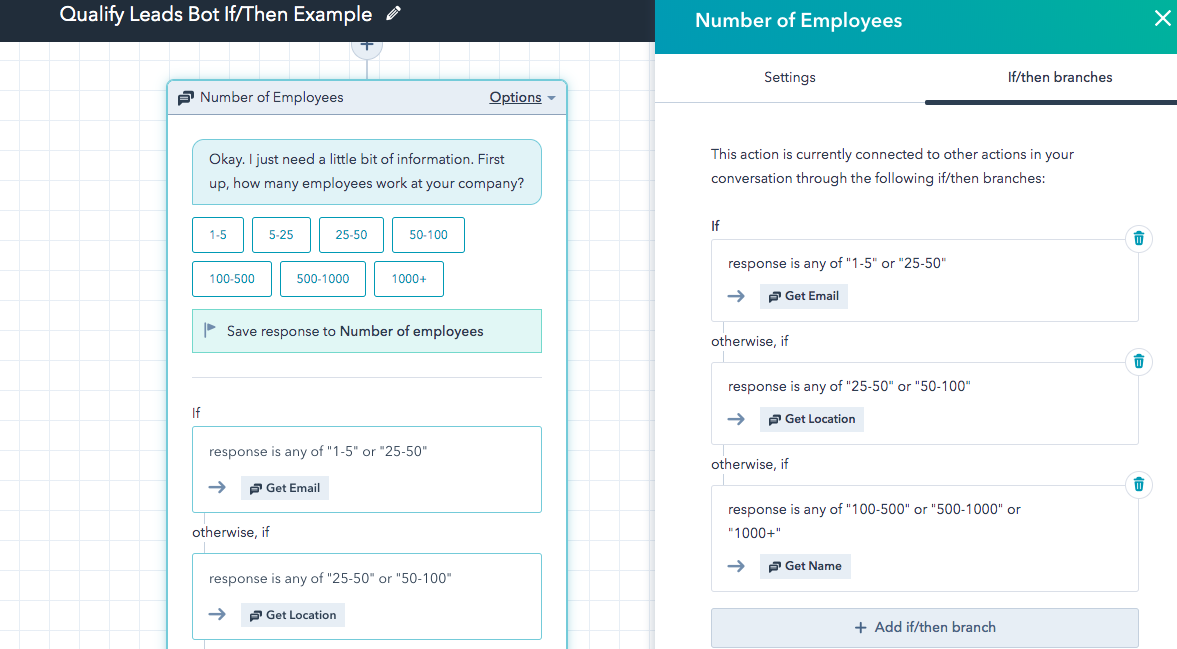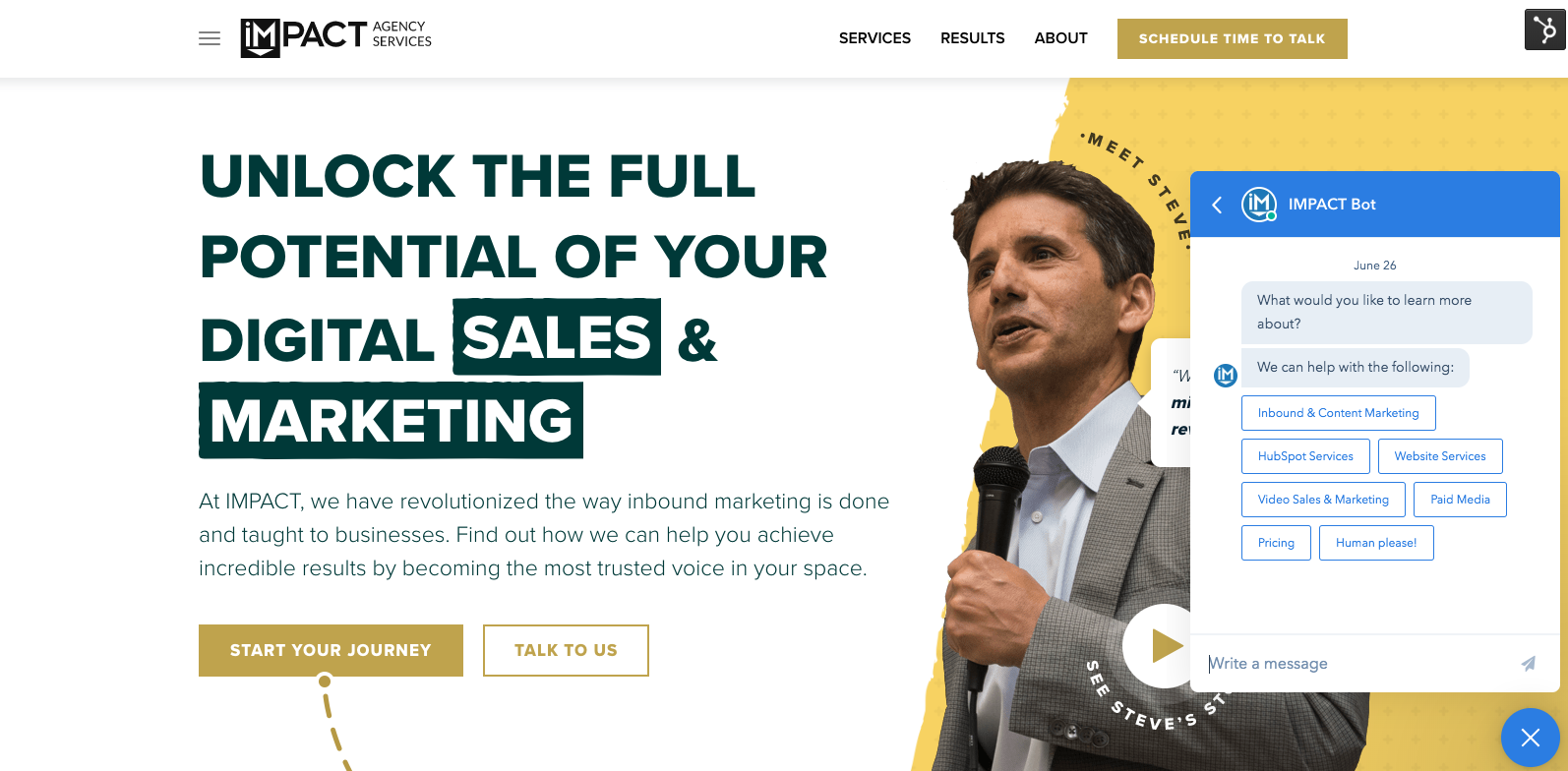Subscribe now and get the latest podcast releases delivered straight to your inbox.
Chatbots vs. Live Chat: Which Do You Use & When on Your Business Website? [Interview]

By John Becker
Jul 3, 2019
![Chatbots vs. Live Chat: Which Do You Use & When on Your Business Website? [Interview]](https://www.impactplus.com/hs-fs/hubfs/latest-chatbots-2019-featured.jpg?width=768&height=400&name=latest-chatbots-2019-featured.jpg)
There are many ways to interact with a company — in person, by phone, by email, or by tweet or other social media. Increasingly, companies are using chatbots and live chat as a first point of contact with website visitors.
But how can a company afford to staff a full-time live chat? Are visitors going to be annoyed by talking to a computer program? How can a chatbot and live chat integrate?
I spoke with IMPACT HubSpot Consultant Nick Bennett about conversations with robots, why live chat is not as expensive as you think, and the importance of touch points.
John Becker: When we first asked you to interview, you suggested discussing chatbots vs. live chat. So, it sounds like maybe you have something to get off your chest.
Nick Bennett: I think the subject of chat in general, whether it's live chat or chatbot, is very appealing to marketers because it feels like it is the next phase. They're looking at their digital presence and thinking, "If we are publishing consistently and our on-page copy is up to par, and it's compelling and it's helpful and it hits all the right notes, what’s next?"
Chat feels like the specific next step, and we get asked all the time, "Where do we even start?" People often hit a wall when implementing chat of any kind because they are trying to do too much all at once. How do you eat an elephant? One bite at a time. Too often, people try to eat that elephant in one bite.
JB: So, who needs to hear this message? What kind of company?
NB: That's an interesting question. It comes back to the greater principles and fundamentals of They Ask, You Answer. Chat is a tool in your toolbelt. If you are a company that is the business of building trust with your prospects and your leads and your customers and your visitors, then chat is for you.
JB: In a perfect world, companies would use both live chat and chatbots. Can you talk about that integration? Where one leaves off and the other picks up, or how they play off each other?
NB: One thing to think about when comparing live chat and chatbots is that, in general, they are not mutually exclusive fields.
You can have one without the other, but it's not always true. And what I mean by that is when you think about having chatbots and live chat together, it's ideally this: the bot function is doing some pretty general qualification and steering a visitor to, for example, sales or support, in one or two clicks before they want to talk to somebody to get a question answered. At a basic level, that's all a chatbot is going to do for you in the beginning. Now how elaborate and how fun you make the experience is up to you.
JB: So a chatbot is typically there to answer one or two questions and then the conversation is handed off to a live person?
NB: As a visitor, there are only so many questions that I'll be willing to answer before I don't get the specific thing that I'm looking for. And so in those moments, we, as users, always want a way to get to a human.
The chatbot can say, "Hey, you didn't get what you're looking for? Here's John. John's going to be able to help you out." Or, "When is a good time for us to get back to you?" if it’s after business hours.
JB: Are chatbots also being used in customer service?
NB: Absolutely. I think that's the piece that people don't consider when they think about chatbots — they're for any customer who is looking for help. It’s much quicker than trying to get someone on the phone or trying to wait for an email response. They offer that one-to-one "solve my problem now."
I think something interesting that I see a lot when people talk about implementing chat in any capacity is they instantly choose to go to chatbot over live chat, over a human interaction. And I disagree with that philosophy for a couple of reasons.
One is that you can make a lot of assumptions as to what you think is important to your visitors, and when you make those assumptions, those are the pathways that the bot will offer. You say, "I think my visitors want A, B, and C, therefore the bot will offer A, B, and C."

But in reality, your customers might want X, Y, and Z, and you will never know because no one ever asked.
Live chat can set the foundation of "What is important? What questions are my prospects actually asking?" It’s how you know what to answer, and it is a critical foundation to having a successful chat experience.
So when we say a company would use both, it's very fluid. Ideally, a chatbot would ultimately lead you to a human.
JB: It sounds like the chatbots are similar to a receptionist. They can't really give you any real detail, but they're going to make you feel comfortable. But if your problems don’t get solved — or the answers aren’t available, it can lead to a bad experience.
NB: If you should take away anything from this chat conversation, it’s that having no experience in chat is better than having a bad experience.
If I go to your website and I have a terrible chat interaction — maybe the bot just didn't make any sense, it took me to the wrong place, or it didn't have the right questions so the answers weren’t helpful. But a bad experience could also happen in live chat. If the person responding is just unhelpful because they're treating the conversation like a way to get to your inbox.
It's very hard to undo a bad chat experience. You’d rather just have someone fill out a support form or email your help desk than click through a chat window only to be met with a “We are away right now” message.
We should always be helpful first.
JB: Do businesses think that they can’t afford someone to do the live chat?
NB: That’s a very common misconception. Probably the greatest overarching barrier to entry for any business is saying, "We don't have the resources to give this the attention we think it deserves."
It’s a huge misconception. Businesses significantly overestimate how much traffic they'll get through their chat in the first place. And so, that fear of the unknown prevents them from ever taking action in the first place.
JB: So you're saying that live chat is not going to be someone's entire job responsibility?
NB: Correct, but you do need to have someone, a marketer, a salesperson or, support team member to keep an eye out and be able to monitor it. But there are fail-safes in place that make the chat go away if no one’s online or everyone is at capacity. Remember, no experience is better than a bad one. You don’t want people saying, "I need help," and not getting a response.
So if you're at capacity or away, no problem.
But thinking "we don't have the resources to man live chat," is usually incorrect.
JB: How does IMPACT staff live chat?
NB: Essentially, we use a bot that qualifies leads: "Are you looking for A, B, or C?" And as long as it's one of the things that we are proficient in as an agency, we give you the option to connect directly with Myriah Anderson. If she’s not available, someone else on our internal marketing team can answer.
Additionally, we can send along helpful resources that might suit the visitor’s needs.

JB: So if the chat comes up, someone's ready to answer.
NB: Yes. When a chat comes through our bot and says, "Human please!” Our team is ready to go.
And this is some of the beauty of the automated chat experience. HubSpot will route it through to the next available person on that team. So whether it goes directly to Myriah, or Kathleen, or Stephanie, or anyone else. Someone will be ready.
JB: If right now, chatbots are step one and step two of a conversation, in five years, are they going to be step two, three, and four of a conversation before you get to a person? Where do you see this technology going in the near future?
NB: It could go a couple of ways. There are chatbots now that you can interact with it and not even know it's a bot, but you also could be interacting with humans and actually think they're bots because of the way that they respond. That happens rather often, especially with larger corporations.
I think chat is at a tipping point where it could become the primary source of contact for a company.
You have a bunch of different ways you can talk to a company. You can fill out a form. You can send them an email. You can call them. You can chat with them. You can go on Facebook. You can tweet at them. You can do any number of things. And chat — both with bots and live — is just another one of those options.
But it's at that tipping point. Can it take off? Can it become one of the more primary drivers of touch points with customers and prospects? I don't know.
I think that we marketers need to remember that our businesses are run by people, for people. You do business with people. If businesses do chat well and remember to keep it human, then yes. Chat will be the ultimate visitor experience.
But if businesses try to dehumanize the experience more and more, relying too heavily on bots and trying to dial back what it is that they're even trying to accomplish, then no.
People don't want to feel fooled. You want to feel that whoever you’re talking to cares, that they are being helpful, and that they're genuinely interested in answering your questions first, and that sales conversation needs to come second.
People can sniff out a bad experience in an instant. Within one or two clicks of utilizing your bot, they'll know if it has the answers they are looking for, and if it doesn’t, they'll bounce and that'll be the end of it.
Remember, having no experience is better than having a bad one.


Order Your Copy of Marcus Sheridan's New Book — Endless Customers!